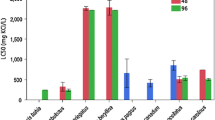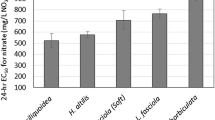Abstract
Clopyralid (3,6-dichloro-2-pyridinecarboxylic acid) is a pyridine herbicide frequently used to control invasive, noxious weeds in the northwestern United States. Clopyralid exhibits low acute toxicity to fish, including the rainbow trout (Oncorhynchus mykiss) and the threatened bull trout (Salvelinus confluentus). However, there are no published chronic toxicity data for clopyralid and fish that can be used in ecological risk assessments. We conducted 30-day chronic toxicity studies with juvenile rainbow trout exposed to the acid form of clopyralid. The 30-day maximum acceptable toxicant concentration (MATC) for growth, calculated as the geometric mean of the no observable effect concentration (68 mg/L) and the lowest observable effect concentration (136 mg/L), was 96 mg/L. No mortality was measured at the highest chronic concentration tested (273 mg/L). The acute:chronic ratio, calculated by dividing the previously published 96-h acutely lethal concentration (96-h ALC50; 700 mg/L) by the MATC was 7.3. Toxicity values were compared to a four-tiered exposure assessment profile assuming an application rate of 1.12 kg/ha. The Tier 1 exposure estimation, based on direct overspray of a 2-m deep pond, was 0.055 mg/L. The Tier 2 maximum exposure estimate, based on the Generic Exposure Estimate Concentration model (GEENEC), was 0.057 mg/L. The Tier 3 maximum exposure estimate, based on previously published results of the Groundwater Loading Effects of Agricultural Management Systems model (GLEAMS), was 0.073 mg/L. The Tier 4 exposure estimate, based on published edge-of-field monitoring data, was estimated at 0.008 mg/L. Comparison of toxicity data to estimated environmental concentrations of clopyralid indicates that the safety factor for rainbow trout exposed to clopyralid at labeled use rates exceeds 1000. Therefore, the herbicide presents little to no risk to rainbow trout or other salmonids such as the threatened bull trout.

Similar content being viewed by others
References
American Society for Testing and Materials (2004) Standard guide for conducting early lifestage toxicity tests with fishes. E1241–05 standard guide for conducting early life-stage toxicity tests with fishes, vol 11.06. Annual book of ASTM standards. American Society for Testing and Materials, West Conshohocken, PA, pp 79–100
Cota JA (2005) National report of pesticide use on national forest system lands: Fiscal year 2004. http://www.fs.fed.us/foresthealth/pesticide/docs/2004pesticideuse_report.doc, 9 pp
Dow AgroSciences (2008) Material safety data sheet: Lontrel herbicide. Dow Agrosciences, Indianapolis, IN
Duncan CA, Jachetta JJ, Brown ML, Carrithers VF, Clark JK, DiTomoso JM, Lym RG, McDanial KC, Renz MJ, Rice PM (2004) Assessing the economic, environmental, and societal losses from invasive plants on rangeland and wildlands. Weed Technol 18:1411–1416
Durkin P, Follansbee M (2004) Clopyralid-revised human health and ecological risk assessment-final report. SERA TR-04-43-17-03c. Syracuse Environmental Research Associates, Inc., Fayetteville, NY. http://www.fs.fed.us/foresthealth/pesticide/pdfs/120504_clopyralid.pdf
Ellersieck MR, Asfaw A, Mayer FL, Krause GF, Lee G (2003) Acute-to-chronic estimation (ACE v 2.0) with time-concentration-effect models: user manual and software. EPA/600/R-03/107. US environmental Protection Agency, Washington, DC
Fairchild JF, Allert A, Sappington LS, Nelson KJ, Valle J (2008) Using accelerated life testing procedures to compare the relative sensitivity of rainbow trout and the threatened bull trout to three commonly-used rangeland herbicides (picloram, 2,4-D and clopyralid). Environ Toxicol Chem 27:623–630
Fairchild JF, Feltz KP, Allert A, Sappington LS, Nelson KJ, Valle J (2009a) An ecological risk assessment of the exposure and effects of 2,4-D acid to rainbow trout (Oncorhynchus mykiss). Archiv Environ Contam Toxicol 56:754–760
Fairchild JF, Feltz KP, Sappington LS, Allert AL, Nelson KJ, Valle J (2009b) An ecological risk assessment of the acute and chronic toxicity of the herbicide picloram to the threatened bull trout (Salvelinus confluentus) and the rainbow trout (Oncorhyncus mykiss). Archiv Environ Contam Toxicol 56:761–769
Federal Register (2004) Joint counterpart endangered species act section 7 consultation regulations; final rule, vol 69, no 150, 50 CFR Part 402, pp 47,732–47,762
Federal Register (2005) Endangered and threatened wildlife and plants: designation of critical habitat for the bull trout; final rule, vol 70, no 185, 50 CFR Part 17, pp 56,212–56,231
Gilliom RJ, Garbash JE, Crawford CG, Hamilton PA, Martin JD, Nakagaki N, Nowell LH, Scott C, Stackelberg PE, Thelin GP, Wolock DM (2006) The quality of our nation’s waters: pesticides in the nation’s streams and ground water, 1992–2001. US Geological Survey Circular 1291. Available from http://pubs.usgs.gov/circ/2005/1291/pdf/circ1291.pdf
Hansen JA, Welsh PG, Lipton J, Cacela D, Dailey AD (2002) Relative sensitivity of bull trout (Salvelinus confluentus) and rainbow trout (Oncorhychus mykiss) to acute exposures to cadmium and zinc. Environ Toxicol Chem 21:67–75
Kiely T, Donaldson D, Grube A (2004) Pesticide industry sales and usage: 2000 and 2001 market estimates. EPA-733-R-04-001, US Environmental Protection Agency Office of Prevention, Pesticides, and Toxic Substances, Washington, DC
Leitch C, Fagg P (1985) Clopyralid herbicide residues in streamwater after aerial spraying of a Pinus radiata plantation. NZ J Forest Sci 15:195–206
Pimentel D, Zuniga R, Morrison D (2005) Update on the environmental and economic costs associated with alien-invasive species in the United States. Ecol Econom 52:273–288
Stehr CM, Linbo TL, Baldwin DH, Scholz NL, Incardona JP (2009) Evaluating the effects of forestry herbicides on fish development using rapid phenotypic screens. North Am J Fish Manage 29:975–984
USEPA (US Environmental Protection Agency) (1999) Update of ambient water quality criteria for ammonia. EPA 882-R-99–014. US Environmental Protection Agency, Cincinnatti, OH
USEPA (US Environmental Protection Agency) (2000) Pesticide ecotoxicity database. Office of Pesticide Programs, Environmental Fate and Effects Division, Washington, DC. Available from http://www/[sstocodeompf/prg/Ref_Aquire.jsp?Rec_Id=PC35924&ReferenceNumber=344
USEPA (US Environmental Protection Agency) (2004) Overview of the ecological risk assessment process in the office of pesticide programs: endangered and threatened species effects determinations. Office of Prevention, Pesticides, and Toxic Substances Office of Pesticide Programs, Washington, DC
Wauchope RD, Buttler TM, Hornsby AG, Augustijn-Beckers PW, Burt JP (1992) The SCS/ARS/CES pesticide properties database for environmental decision-making. Rev Environ Contam Toxicol 123:1–155
Weed Science Society of America (2002) Herbicide handbook, 8th edn. Weed Science Society of America, Lawrence, KS
Acknowledgments
We thank Lynne Johnson Steve Olson, and Deanna Stoppler for their technical assistance on the project. Clopyralid was donated by Dow Agrosciences LLC. Nile Kemble and Thomas May provided reviews of the paper under the USGS Fundamental Science Practices Policy. We thank two anonymous reviewers for their helpful comments on the manuscript. This study was jointly funded by the US Fish and Wildlife Service’s Division of Environmental Quality Off-Refuge Contaminant Investigation Program (Agreement 6018-1-3-N5), the US Forest Service Pesticide Impact Assessment Program (Agreement 03-IA-1015600-040), and the US Geological Survey. No private funding was requested or received in the conduct of these studies. Any use of trade, product, or firm names is for descriptive purposes only and does not imply endorsement by the US Government.
Author information
Authors and Affiliations
Corresponding author
Rights and permissions
About this article
Cite this article
Fairchild, J.F., Allert, A.L., Feltz, K.P. et al. An Ecological Risk Assessment of the Acute and Chronic Effects of the Herbicide Clopyralid to Rainbow Trout (Oncorhynchus mykiss). Arch Environ Contam Toxicol 57, 725–731 (2009). https://doi.org/10.1007/s00244-009-9381-0
Received:
Accepted:
Published:
Issue Date:
DOI: https://doi.org/10.1007/s00244-009-9381-0




